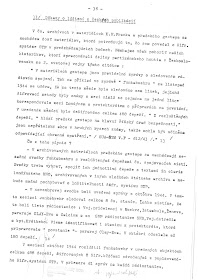During the
year I continued to research several cases of cryptologic history. I got material
from the US, British, German and Czech archives, I helped a lot of researchers
by giving them information/files and I’ve also received some interesting
material from my friends.
In January I
had a look at some Unanswered
questions of WWII cryptology and I presented information on the Compromise
of a US cipher teleprinter in 1944.
In February I
wrote about the German
signals intelligence files in the Russian national archives and I added
material on the compromise
of OSS codes in WWII.
In March I
presented more information on the possible
exploitation of the Japanese PURPLE cipher by the German codebreakers. I
also gave an overview
of reports on the compromise of Allied communications in WWII.
In April I
covered The
ciphers of Czechoslovakia’s government in exile.
In May I
added information in my essay on Case
Wicher, I presented detailed
information on the use of the M-138-A cipher by the US State Department and
I posted Erich
Hüttenhain’s statements on the solution of the M-138-A cipher from his
unpublished manuscript ‘Einzeldarstellungen
aus dem Gebiet der Kryptologie’.
In June I
uploaded 3
missing pages from TICOM report I-22 and also the finding
aid for the National Cryptologic Museum Library.
In July I
looked back at all the information that I’ve uncovered these past few years in
my essay July
2011 to July 2016 - 5 years of Christos military and intelligence corner
and I wrote a
review of ‘Code Warriors: NSA's
Codebreakers and the Secret Intelligence War Against the Soviet Union’.
In August I
added information on the US
military attaché emergency double transposition cipher, I copied material
from the British report FO
850/171 ‘Preparation of telegrams: use of code words: cypher machines and
traffic: teleprinter services: en clair messages. Code 651 file 1 (to paper
4968)’ and added parts in my Typex essay and I uploaded Special
Research History SRH-368 ‘Evaluation
of the Role of Decryption Intelligence in the Operational Phase of the Battle
of the Atlantic, U.S. Navy OEG Report #68’.
In September
I gave an
overview of the status of my recent FOIA cases, I added information on the Soviet
analysis of the Enigma cipher machine and I located a NATO
report critical of Hagelin C-type crypto machines.
In October I
linked to two Australian reports detailing Japanese diplomatic and military
codes of WWII. After receiving the book ‘KODY WOJNY. Niemiecki
wywiad elektroniczny w latach 1907–1945’ I added some information from
it in
my essays on the German exploitation of Polish codes. Also during the month
I uploaded the finding
aid to the TICOM collection in the German Foreign Ministry’s Political Archive.
In November I
added information on the history of US
ciphers from the book ‘The history of codes and ciphers in the United States
during the period between the world wars part ii. 1930-1939’ , I added
information from the War Diary
of Inspectorate 7/VI on the German analysis of Soviet cipher teleprinters of
WWII and I uploaded several decoded
Irish diplomatic telegrams from 1944.
In December I
added information from the report ‘Dopady lúštenia šifrovacieho systému čs.
londýnskeho MNO z rokov 1940-1945 na domáci odboj’ in my essay on The
ciphers of Czechoslovakia’s government in exile.
Hopefully in
2017 I will be able to cover the few remaining cases of cryptologic history
that interest me.

























